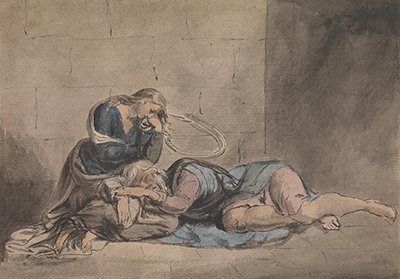In William Blake's Lear and Cordelia in Prison, King Lear, weary with age and weighed down by realisation of his errors of judgement, sleeps in the lap of his daughter. Cordelia reflects on disruption to the kingdom, including his rejection of her, but also grieves for her father's distress.
Blake's planned series on historical subjects was never finished, but The History of England was completed around 1779, and includes Tate Britain's Lear and Cordelia in Prison. It is obviously based on William Shakespeare's King Lear, although this scene was not part of the original play. It was, however, included in an eighteenth-century interpretation by Nahum Tate which Blake may have seen. Alternatively, his source might have been John Milton's History of Britain, with Lear portrayed as the last descendant of Brutus, and the first English monarch.
As a child born in 1757, Blake had religious visions, and he often used biblical subjects as an adult. After a spell in a drawing school, and an apprenticeship to an engraver, he enrolled at London's Royal Academy Schools. He preferred classical sculptures and Greek vases to life drawing, with the neoclassical movement becoming a lifelong influence.
The Royal Academy's president, Sir Joshua Reynolds, advised the young William Blake to consider using a simpler style. It's possible to see that influence in Lear and Cordelia in Prison, although it's also true that the artist was always meticulous in any medium.
The picture was executed in ink and watercolour on paper, like much of Blake's output. He first experimented with watercolours in 1777, but his approach was different from that of other artists. At that time, the medium was considered inferior to oil, so the tendency was to make any other materials appear as close as possible to the look of oil. Blake actually continued to use watercolour throughout his life, complaining that oil didn't convey or hold the brilliance that he intended.
He would first sketch in pen and ink, or graphite, using it as a basis for the completed work. In most of his paintings, this outline can still be seen, as is the case with Lear and Cordelia in Prison. After a broad wash, he layered short and light brushstrokes, adding ink lines for definition, sometimes beyond outlines, with tints to convey depth where necessary.
William Blake was also a talented poet and printmaker, and although not appreciated in his lifetime, he is now regarded as a visionary and an important figure of the Romantic period in several disciplines. The Pre-Raphaelites were early admirers, and his relevance has continued by way of the 1950s Beat Poets and 1960s popular culture. He is still referenced regularly today.




